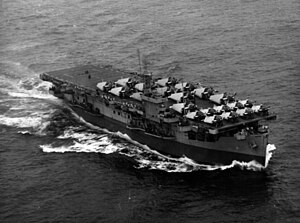 USS Block Island underway with a deckload of aircraft, 15 October 1943.
| |
| History | |
|---|---|
| Name | USS Block Island |
| Namesake | Block Island Sound |
| Builder | Seattle-Tacoma Shipbuilding Corporation |
| Laid down | 19 January 1942 |
| Launched | 1 May 1942 |
| Sponsored by | Mrs. H. B. Hutchinson |
| Commissioned | 8 March 1943 |
| Honors and awards | 2 Battle Stars |
| Fate | Torpedoed by U-549; scuttled by escort screen, 29 May 1944 |
| General characteristics | |
| Class and type | Bogue-class escort carrier |
| Displacement | 16,620 long tons (16,887 t) |
| Length | 495.66 ft (151.08 m) |
| Beam | 111 ft 6 in (33.99 m) |
| Draft | 26 ft (7.9 m) |
| Installed power | 8,500 shp (6,300 kW) |
| Propulsion |
|
| Speed | 18 kn (21 mph; 33 km/h) |
| Complement | 890 officers and men |
| Armament | 2 × 4"/50, 5"/38 or 5"/51/38 cal dual purpose guns |
| Aircraft carried | 24 |
| Aviation facilities | 2 × elevators |
USS Block Island (CVE-21/AVG-21/ACV-21) was a Bogue-class escort carrier for the United States Navy during World War II. She was the first of two escort carriers named after Block Island Sound off Rhode Island and was the only American carrier sunk in the Atlantic during the war.
Originally classified AVG-21, she became ACV-21 on 20 August 1942, and CVE-21 on 15 July 1943.[1] She was named after Block Island, an island in Rhode Island east of New York.[2]
- ^ "CVE21 History". www.ussblockisland.org. Retrieved 12 November 2016.
- ^ "Escort Carrier Photo Index: USS Block Island (ACV-21)". www.navsource.org. Retrieved 12 November 2016.